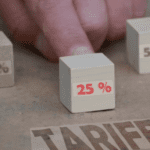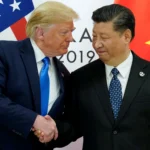As US President Donald Trump’s July 9 deadline for imposing up to 50% tariffs on European goods draws closer, EU leaders gathered in Brussels on Thursday to strategise their response – and possibly avert a new transatlantic trade war.
European Commission President Ursula von der Leyen confirmed the bloc had received a new negotiating document from the US and is “ready for a deal.” But she added that “all options remain on the table” in case talks fail.
“We are preparing for the possibility that no satisfactory agreement is reached… and we will defend the European interest as needed,” von der Leyen told reporters early Friday.
A Split Union: Fast Deal or Push Back?
Germany and Italy are urging for a swift and slim agreement to provide clarity to exporters. German Chancellor Friedrich Merz emphasized that “a quick and simple deal” is better than dragging negotiations, especially with Germany’s carmakers facing existing 25% auto tariffs.
But France is resisting what it sees as a lopsided offer. President Emmanuel Macron warned that accepting asymmetric terms could harm Europe’s competitiveness and set a dangerous precedent with future trade partners like India or China.
“Goodwill should not be seen as weakness,” Macron said, adding that if the US keeps its 10% baseline tariffs, Europe’s response must match in strength.
What’s on the Table?
EU negotiators are considering:
- Reducing non-tariff barriers
- Increasing purchases of US goods
- Exploring a tariff-rate quota system
- Enhancing cooperation on China-related issues
A temporary suspension of EU tariffs on €21B worth of US goods remains in place until mid-July to allow negotiations to proceed. Meanwhile, the EU is consulting on a fresh set of retaliatory tariffs that could hit up to €95B in American exports if talks collapse.
Industry Pressure and WTO Reform
Business leaders are warning of the economic fallout if no deal is struck. Germany’s Federation of Industries (BDI) estimates Trump’s tariffs could shave 0.3 percentage points off Germany’s GDP. EU Chief Trade Negotiator Maroš Šefčovič said Europe’s car sector is “clearly bleeding” and pushed for a “standstill clause” to prevent sudden tariff hikes.
At the same time, von der Leyen floated the idea of reviving the World Trade Organization with a new global trade coalition, hinting at structured collaboration with Asia-Pacific nations.
“We can think of this as the beginning of redesigning the WTO… to show the world that free trade on a rules-based foundation is still possible,” she said.
What’s Next?
With time running out before Trump’s July 9 deadline, the EU faces two choices: finalize a modest deal quickly, or prepare for a confrontation. Diplomats admit the path is narrow and politically risky.
Negotiators are expected to resume talks in the coming days, but no specifics from the US proposal – described as a “two-pager” – have yet been disclosed. Until then, the EU stands on edge, ready for peace, but preparing for war.
Disclosure: This article does not represent investment advice. The content and materials featured on this page are for educational purposes only.
Related:
Trump’s Tariff Deadline? ‘Not Critical,’ Says White House
Nike Reports After the Bell: Here’s Why Wall Street Expects a Weak Quarter
US IPOs Soar 53% in 2025, Led by Circle and CoreWeave — But Can the Boom Last?
In a First-of-Its-Kind Decision, Anthropic and Meta Win Copyright Lawsuits Brought by Authors
Kalshi Hits $2 Billion Valuation as Prediction Markets Go Mainstream
S&P 500 Nears All-Time High After Stunning Rebound from April Lows
Trump rebukes Israel and Iran hours after ceasefire: Latest Updates










